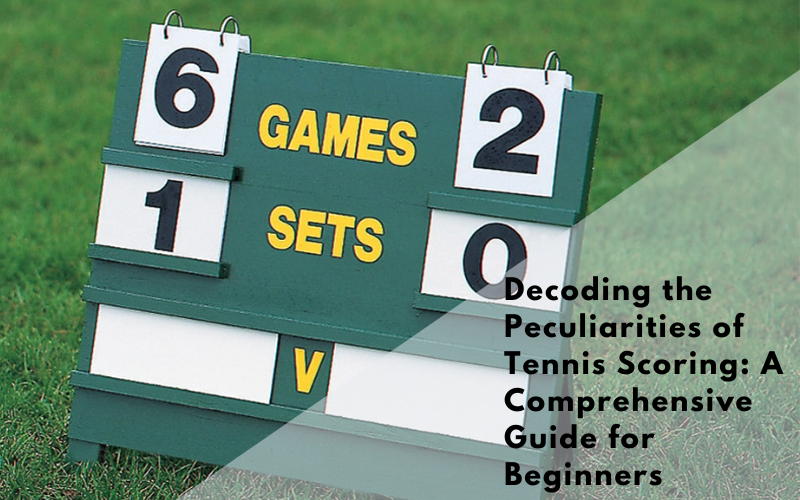If you’re new to tennis, the scoring system might seem confusing. But fear not, there’s an explanation for why it is the way it is! The numbers used in tennis scoring – 15, 30, 40, and even “Love” – represent a unique and historic system. However, the origins of this system are not widely known. Keep reading to find out more about the history of tennis scoring.
Table Of Contents
- Understanding Tennis Scoring: A Beginner’s Guide
- FAQs
- What is the term for a tied score of 6-6 in tennis?
- What Determines Whether a Set Goes to 7 in Tennis?
- What is the correct scoring system in tennis?
- What is the duration of a bathroom break in tennis?
- What is the meaning of ‘deuce’ in tennis scoring?
- What Does ‘Broken Serve’ Mean in Tennis?
- Why does the tennis score jump from 30 to 40 instead of 35?
- Summing Up
Understanding Tennis Scoring: A Beginner’s Guide
Many theories have been proposed to explain the origin of tennis scoring, but its true roots are uncertain. One popular theory suggests that the scoring system is based on a clock face, with each quarter representing 15, 30, 45, and then 40 points.
Another theory attributes the scoring system to Jeu de Paume, a predecessor of tennis, which was played on a court measuring 90 feet end-to-end. Players advanced towards the net after each point, moving 15 feet, then 30 feet, and finally 45 feet before moving back 10 feet to avoid colliding with their opponent.
This progression added up to a total of 40 points, which became known as “deuce.” However, these are just theories, and there is no scientific evidence to confirm their validity.

FAQs
What is the term for a tied score of 6-6 in tennis?
When a tennis match reaches 6-6 in a set, a tiebreak game is played to determine the winner. This is a first-to-seven point game, with players alternating serves every two points. The player who first reaches seven points with a two-point advantage wins the tiebreak and the set.
It’s important to note that the scoring system in a tiebreak is different from regular play, and points are counted as follows: 0 points = 0, 1 point = 1, 2 points = 2, and so on, until a player reaches 7 points.
What Determines Whether a Set Goes to 7 in Tennis?
When playing tennis, a set is won by the player who wins six games first. However, if both players have won five games each, a special tiebreak round will be played to determine the winner of the set. This tiebreak round is played until one player reaches seven points, but they must win by a margin of two points. Therefore, the final score of a set could be 6-4 or 6-3, but not 6-5. In the event that the score reaches 5-5, the only way to determine the winner of the set is to play until someone wins by a margin of two points, either 7-5 or 7-6.
What is the correct scoring system in tennis?
Tennis scoring can be initially confusing and leave you wondering why it is so peculiar. However, here is a simple guide to help you understand it better. When no points have been scored, we call it “love.” Once a player scores one point, it becomes “15,” and if they score two points, it becomes “30.” Scoring three points makes it “40.” If both players or teams have the same score, it is called “all.” When the score is tied at 40-40, we call it “deuce.” If the server or receiver wins the deuce point, a special term is used for each case. When the server wins, it is called “ad-in,” and when the receiver wins, it is “ad-out.”
What is the duration of a bathroom break in tennis?
Players are now allowed to take only one bathroom break per match, and it should last no longer than three minutes. These new rules have been confirmed by the ATP in 2022, following a controversy at the US Open Championship involving Andy Murray and Stefanos Tsitsipas. Murray accused Tsitsipas of taking too long to return from his bathroom break during their first-round match. These guidelines ensure that the matches proceed smoothly without causing any inconvenience to the opponent.

What is the meaning of ‘deuce’ in tennis scoring?
In tennis, “deuce” is a term used when both players have scored 40 points, resulting in a tie. This situation is also known as a tiebreak. When deuce occurs, one player must win two consecutive points to win the game. If the server wins a point with no response from their opponent, they are said to be “ad-in”. However, if they lose the next point, they are said to be “ad-out”. It’s essential to understand these terms when playing tennis to avoid confusion and ensure fair play.
What Does ‘Broken Serve’ Mean in Tennis?
A break of serve happens when a player loses his/her service game to the opponent. The most common score in tennis matches is 6-4.
Winning a break of serve at this score is considered good since it typically results in just one break. Some players rely heavily on their serving ability, while others depend on their return shots.
For instance, Novak Djokovic has a formidable return game that makes him one of the best players in tennis.
Why does the tennis score jump from 30 to 40 instead of 35?
The origins of the tennis scoring system are shrouded in mystery, but one theory dates back to the 15th century. According to this theory, the scores were displayed on two clock faces, each ranging from 0 to 60. The numbers 1 to 15 would be shown first, followed by 30, and then 45, which was later shortened to 40 when the clocks were no longer used.
However, this theory hasn’t been definitively proven. Regardless of its origins, the scoring system is now an essential part of the game of tennis.
Summing Up
This article aimed to provide a clear explanation of the tennis scoring system to help those who may be unfamiliar with the sport to better understand it.
Hopefully, after reading this article, you now have a solid understanding of the scoring system and will no longer wonder why it is so peculiar.
Thank you for taking the time to read this article, and we hope you enjoy watching or playing tennis in the future!

